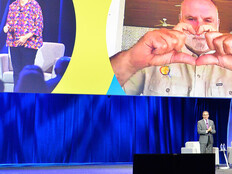1. Do We Have a Need for Truly Future-Proof Hardware?
Wi-Fi 7 is designed to support next-generation applications, including 8K video streaming, augmented reality, virtual reality, home healthcare delivery, real-time monitoring and artificial intelligence-powered diagnostic tools. By adopting Wi-Fi 7 now, your organization can ensure its network is ready for the high-bandwidth, low-latency demands of these emerging technologies, giving you a competitive advantage over other health systems and providing a better experience for clinicians, staff and patients.
2. Is Network Congestion a Daily Challenge For Our Hospital Campus?
With the high density of clinician and patient devices, and the proliferation of the Internet of Medical Things devices, hospital campus Wi-Fi networks are more crowded than ever. Wi-Fi 7’s advanced features, such as Multi-Link Operation and preamble puncturing, are specifically engineered to mitigate interference and deliver reliable connections even in the busiest hospitals. MLO allows devices to simultaneously connect on multiple frequency bands, aggregating them for faster speeds or providing redundancy for enhanced reliability, which is crucial for real-time communication and care delivery.
EXPLORE: Why should healthcare organizations undergo a networking health check?
3. Are Our Current Network Solutions Failing To Meet Our Needs?
If the organization is struggling with slow speeds, buffering or dropped connections even after a recent upgrade, it may indicate a need for more than just incremental improvement. Wi-Fi 7’s substantial gains in speed and efficiency could be the solution, particularly for bandwidth-intensive activities such as cloud computing, real-time collaboration and large-scale file transfers.
4. What Is the Cost of Upgrading Both Our Infrastructure and Devices?
The full benefits of Wi-Fi 7 can only be realized when both the network infrastructure (access points, controllers, switches) and end-user devices (laptops, tablets, smartphones) are Wi-Fi 7-compatible. While Wi-Fi 7 is backward-compatible, IT leaders must budget for new hardware and a phased rollout that aligns with device refresh cycles. The cost of a campuswide refresh can be substantial and requires careful planning and strategic partnerships to ensure a smooth transition.
5. What Is the ROI of a Wi-Fi 7 Upgrade?
For many health systems, the ROI is not only about faster Wi-Fi but about enabling new research opportunities and care delivery methods. Wi-Fi 7 can support cutting-edge research, enhance hybrid and virtual care, and improve the overall clinician and patient experience, which can be a powerful recruitment and retention tool. The cost must be weighed against these strategic benefits.











